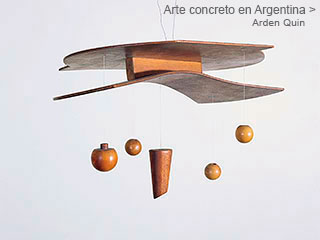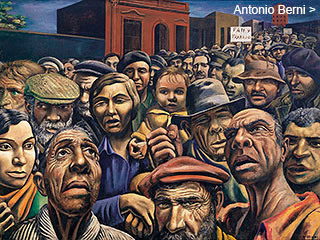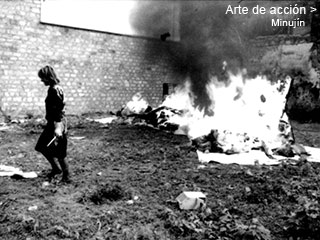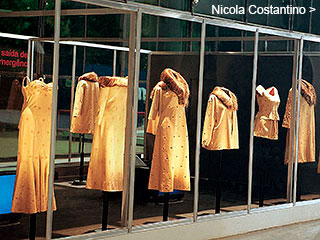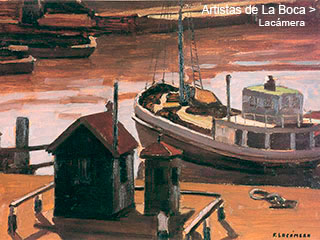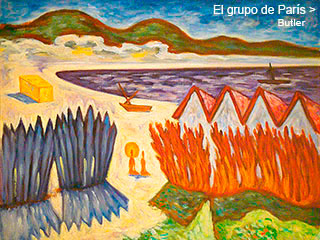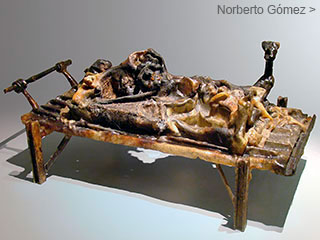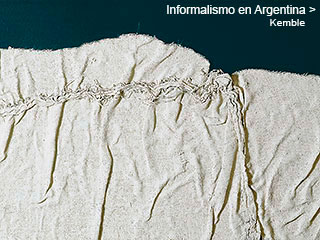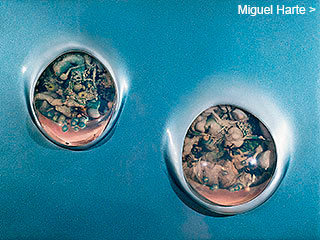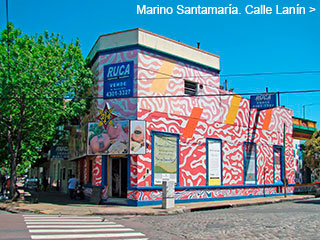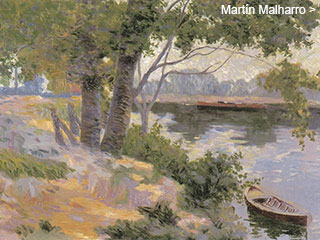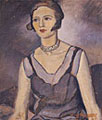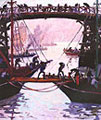Menú
Algunos dossiers
La Boca
Artists
Artists
by
Florencia Battiti and Cintia Mezza
August 2006
August 2006
We are about to venture into the fascinating world of the famed La Boca artists. This dossier reviews the gravitations of the modernization process of Argentine art throughout the last one hundred years, and the role that its growing cultural institutions played along the way. This investigative work has been authored by Florencia Battiti, and assisted by Cintia Mezza.
5. Appendix I: Culture and neighborhood
The Ateneo Popular de La Boca
Founded on December 7, 1926, the Ateneo Popular de La Boca is the first cultural institution that not only plays an important role in the neighborhood, but also transcends its frontiers to become a space for debate in the center of the city.
From its very beginnings, the Ateneo builds up prestige in the local art scene. This institution promotes published material, offers conferences, teaches cultural extension courses, exhibits work of plastic artists, organizes events and contests as well as literary and music contests and impulses the integration of the immigrant population to the neighborhood through the commemoration of national patriotic dates such as the IV Hundred Centenary of the first foundation of Buenos Aires or the 150th Anniversary of the May Revolution.
Important promoters of culture such as E. Payró and Jorge Romero Brest discuss and publish articles describing the activities of the Ateneo.
This last one, from the pages of La Vanguardia, kudos the exhibits' programming, which is based, to his understanding, on didactic criteria, very useful for the formation of taste and the artistic trade.
In tune with the IV Exposición Estímulo that Romero Brest describes in the newspaper, he points out that the Ateneo Popular de La Boca organizes shows of young and progressive artists, but of accomplished ones as well. In this “cordial and intimate atmosphere, proper of the youthful expressions, they give the most experienced artists a lesson on wisdom and domains over their sensibility”.  The critique refers to, among others, the expositions of Aquiles Badi, Pedro Figari, Alfredo Guttero, Lino E. Spilimbergo and Miguel C. Victorica that the Ateneo makes between 1927 and 1938. Also, in the same exposition that he points out, the work of art of emerging artists mix in with the work of established artists such as Forner, Pissarro, Bigatti, Victorica and Guttero. Significantly important, the amazement of the art critic increases when he realizes that the novel artists that show their work “search with a strange uniformity, the deep poetic expression that the landscapes or the everyday things contain. But they do not apply any magic formulas or known solutions”
The critique refers to, among others, the expositions of Aquiles Badi, Pedro Figari, Alfredo Guttero, Lino E. Spilimbergo and Miguel C. Victorica that the Ateneo makes between 1927 and 1938. Also, in the same exposition that he points out, the work of art of emerging artists mix in with the work of established artists such as Forner, Pissarro, Bigatti, Victorica and Guttero. Significantly important, the amazement of the art critic increases when he realizes that the novel artists that show their work “search with a strange uniformity, the deep poetic expression that the landscapes or the everyday things contain. But they do not apply any magic formulas or known solutions”  Romero Brest shows his surprise when he can´t find “paintings of the likes of Spilimbergo, or Victorica, or Guttero, etc”, as you would find in the official exhibition rooms.
Romero Brest shows his surprise when he can´t find “paintings of the likes of Spilimbergo, or Victorica, or Guttero, etc”, as you would find in the official exhibition rooms.
As of its foundation, one of the objectives of the members of the Ateneo would be to edit their own communications media. Directed by Alberto Carlos Antelo, El Ateneo is the first newspaper published by this institution. It did not last long. Its pages were filled with information about its objectives and goals. It is followed with Riachuelo, which first appears in 1931. It was directed by Antonio Bucich, and it expressed a more literary form, self-proclaiming itself “the organ of the expression of the new Boquense generation”. It also did not last long, as its last number appears on December, 1931.
Vida del Ateneo (Life of the Ateneo),which is published from 1937 to 1941, and the magazine Pórtico –which manages 16 issues– are perhaps the most recognized graphic media that the institution promotes. Considered one of the most important local journalistic manifestations of the time, Pórtico stood out not only in La Boca, but throughout the country and abroad.
To date, theAteneo Popular de La Boca, located on 315 Benito Pérez Galdós St., keeps its doors open to the community. Directed by Aldo Lazzari, son of the Italian painter who was the teacher of the most relevant artists of the borough, El Ateneo continues its silent work offering cultural activities with the only purpose to offer a variety of opportunities to the new generations.
Agrupación Gente de Arte y Letras Impulso
(People of Arts and Letters Impulse Group)
(People of Arts and Letters Impulse Group)
Founded on March 23, 1940, the Asociación Impulso (Impulse Association) –as it is commonly called– meets at the beginning at Fortunato Lacámera's studio, its president from 1940 to 1951, the year this painter dies. The association then moves to a typical humble house of La Boca made of wood and zinc, on 355 Lamadrid St.
Together with Ateneo, Impulso takes on a special place in the artistic “Boquense” circle. As M. Teresa Constantín would point out in a work dedicated to the institution, the objectives set out on the founding act –a solidarity filled will of the artist’s union, diffusion of art, and free drawing, painting and decorative arts classes to the people– are “hereditary to the traditions of associations of the town of La Boca, where you could also find the blue collar worker ideology of the time, among them, anarchism”. 
From its beginnings, Impulso sets out to accomplish eight exhibits per year, two of them collective and six individual. In time, the growing demand from the public increases their showings. A rich and heterogeneous group of Argentine artists have paraded through its show rooms, ranging from members of the Grupo de París (Paris Group) to representatives of the Martín Fierro vanguard of the 1920´s. Among them, exhibit at Impulso Juan Carlos Castagnino, Raúl Russo, Vicente Forte, Manuel Espinosa, Ramón Gómez Cornet, Jorge Larco, Raquel Forner, Emilio Centurión, Héctor Basaldúa, Leopoldo Presas, Giordano La Rosa, Raúl Soldi, Lucio Fontana Lino E. Spilimbergo and Emilio Pettoruti.
Of course they couldn´t do without individual exhibits dedicated to specific artists from La Boca, such as Eugenio Daneri, Alfredo Lazzari, Orlando Stagnaro, Marcos Tiglio, Onofrio Pacenza and Lacámera Daneri himself. In 1949, the 100th exhibition is celebrated with a show that gathers Miguel Carlos Victorica, Lacámera and Quinquela Martín. In addition, it organized exhibits of the work produced by its members, which were put together in cultural centers and social clubs nearby with which Impulso kept close contact with.
Thanks to the rich panorama of Argentine art exhibited at this center, Impulso takes on an important role in the diffusion of art and cultural formation of the neighbors of La Boca, many of which decided to stay close to this neighborhood in order to take part in this type of activities.
This alternative artistic formation that develops in La Boca starts with Alfredo Lazzari and his night classes held at Sociedad Unión (Union society). Impulso soon aligns itself with this tradition, organizing drawing and painting classes which are complimented with the creation of a library specializing in art.
Besides the promotion of the sales of works of art at its center, Impulso also tries to sell its work in the downtown area. This is how, in 1943, it organizes a collective exposition in Harrod's which was inaugurated by L. Pagano, a renowned critic who in this way legitimizes the initiative of these novel “borough” artists. 


